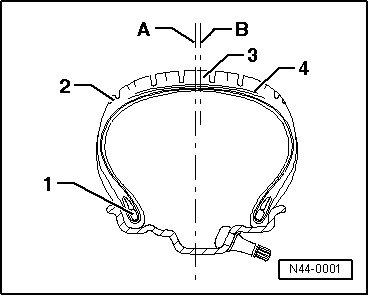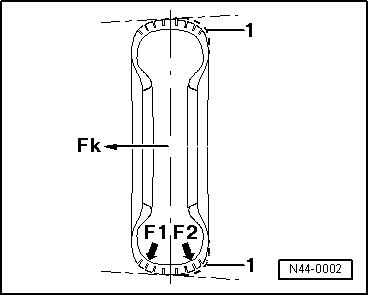Volkswagen Polo Service & Repair Manual: Taper
| Taper is caused by slightly offsetting the tread and/or the
belt by a few tenths of a millimeter from the geometric center
of the tire. Taper cannot be recognized visually nor can it be
measured with workshop equipment. |
|
|
|
| A - |
Geometric center of tire |
| B - |
Actual position of belt. It can be offset to inside or
outside. |
|
|

|
| Shown out of proportion to provide a better illustration. |
| F1 - |
Unequal forces on contact patch |
| F2 - |
Unequal forces on contact patch |
| The offset produces differences in rigidity of the inner and
outer shoulders of the tire, which lead to differing forces on
the contact patch. Due to this, the belt and tread will not be
pressed against the road surface with the same force (F1, F2). A
taper forms. The resulting force (force of taper Fk) can become
so large depending on speed, that the vehicle pulls to one side. |
| If the force (Fk) on one wheel of the axle is, for example,
50 Newton and on the other wheel also 50 Newton, and both forces
are exerted in the same direction, the forces are additive.
Reversing a tire on the rim can compensate for the pulling
because the forces then act against each other. |
| Because the direction in which the force of taper is exerted
is not visible at the tire, only road tests and targeted
rotation of wheels and tires can establish which tires cause the
pulling. |
| The tire consists of numerous components and materials which
are vulcanized to a single part at the end of a complicated
manufacturing procedure. This leads to differing construction
tolerances which can make themselves noticeable through more or
less strong lateral forces (lateral forces of taper). These
forces can also develop in new tires. |
| One-Sided Pulling on Front Axle |
| Pulling to one side can be caused by the suspension.
However, experience shows that in 90% of all complaints, the
tires cause pulling to one side. |
| One-Sided Pulling During Normal Driving Style |
| On a straight, level road surface, the vehicle wants to pull
to one side at a constant speed or with moderate acceleration. A
force can be felt at the steering wheel. |
| One-Sided Pulling During Strong Accelerating |
| Pulling to one side during fast acceleration is, in part,
due to the design of vehicles with front wheel drive. Various
frictional conditions of left and right wheels, for example,
possible irregularities in the road surface (pot holes) and
consequently varying adhesion to ground have a substantial
influence on the handling characteristics. This does not
constitute a complaint in the sense of warranty coverage. |
|
|

|
Perform a road test to determine if a vehicle pulls to one
side and if so, when and to which side. If the vehicle pulls to
one side. Refer to
→ Chapt ...
Test Conditions Before and During the Road Test
–
Check all suspension components on front and rear axle for
damage.
...
Other materials:
Introduction
This chapter contains information on the following subjects:
→ Positive and earth jump lead connection points
→ How to start the engine using jump leads
If the engine fails to start because the vehicle battery is flat, the flat
battery can be connected to the battery of anothe ...
Evacuating and Charging Valve, Low Pressure Side
Special tools and workshop equipment
required
Torque Wrench 1783 - 2-10Nm -VAG1783- with Torque Wrench
1783 - 1/4" Drive Ratchet -VAS6234-
WARNING
There is a dan ...
Tires, Aging
Even tires that look in good shape, new or hardly use and
have sufficient tread depth and that are older than 6 years, can
age caused by moisture and winter conditions.
Tire test show that through continual development, new
rubber ...
© 2016-2025 Copyright www.vwpolo.net

 General Information
General Information Corrective Action When Vehicle Pulls to One Side
Corrective Action When Vehicle Pulls to One Side

